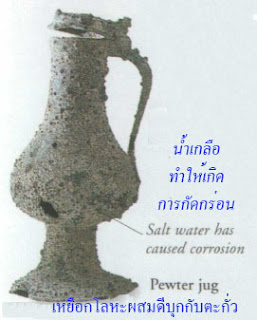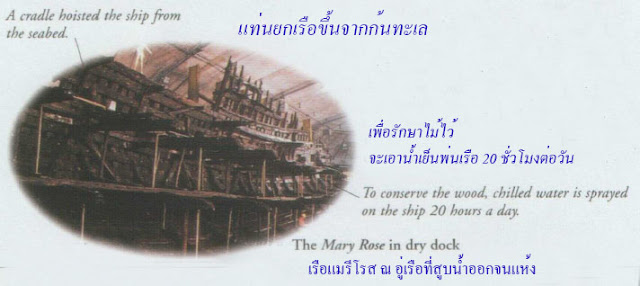ARCHAEOLOGY
HUMANKIND
HAS ALWAYS been fascinated by the question of who we
are, where we came from, and how we used to live. Archaeology
is the study of our past, from early prehistory onward, using the material
remains of our ancestors and the possessions they left
behind. Over thousands of years, evidence of
human activity, such as camp fires, rubbish tips, and dwellings, become buried. Archaeological teams
discover these sites and uncover this evidence by
careful excavation. The material is then conserved
and studied in order to help the archaeologist piece together
a picture of how people lived and died in the past.
|
โบราณคดี
มนุษยชาติชอบมีคำถามเสมอ
ๆ ว่า เราคือใคร เรามาจากไหน และเราจะต้องดำเนินชีวิตอย่างไร โบราณคดีคือการศึกษาเรื่องราวในอดีตของพวกเรา
ตั้งแต่สมัยยุคก่อนประวัติศาสตร์ ด้วยการใช้ซากวัสดุของบรรพบุรุษของพวกเราและทรัพย์ที่พวกท่านทิ้งไว้ในเบื้องหลัง
หลักฐานกิจกรรมของมนุษย์ เช่น ค่ายไฟ กองขยะ และสถานที่พักอาศัย ที่ถูกฝังไว้มากกว่าหลายพันปี
คณะนักโบราณคดีได้ค้นพบแหล่งโบราณคดีเหล่านี้และเปิดเผยหลักฐานโดยการขุดค้นทางโบราณคดีอย่างระมัดระวัง
ครั้นแล้ววัตถุเหล่าก็ได้รับการเก็บรักษาไว้และได้รับการศึกษาเพื่อช่วยให้นักโบราณคดีปะติดปะต่อภาพให้ทราบว่าผู้คนดำเนินชีวิตและสิ้นชีวิตในอดีตอย่างไร
|
|||
Discovery
Archaeological sites
are found during building work,
through reading historical documents, geophysical
surveys (the study of the soil's structure), and field walking (recording above-ground objects).
Aerial
photography
Horizontal and vertical
lines seen from the air often show medieval strip fields,
ancient roads, walls, and ditches. Aerial photography
done when the sun is low shows varying surface levels,
moisture levels, and vegetation most clearly.
|
การค้นพบ
แหล่งโบราณคดีจะถูกค้นพบในระหว่างการทำงาน
ด้วยการอ่านเอกสารทางประวัติศาสตร์ การสำรวจธรณีฟิสิกส์
(การศึกษาโครงสร้างของดิน) และเดินภาคสนาม
(การบันทึกวัตถุประสงค์เหนือภาคพื้นดิน)
ภาพถ่ายทางอากาศ
เส้นแนวนอนและแนวขวางซึ่งมองเห็นจากอากาศจะเผยเห็นทุ่งนาเป็นแนวยาว
ถนนโบราณ กำแพง และคูคลองในยุคกลางเสมอ ๆ
ภาพถ่ายทางอากาศถ่ายไว้ในขณะที่ดวงอาทิตย์กำลงจะตกแสดงให้เห็นระดับพื้นผิวโลกที่แตกต่างกัน
ระดับความชื้น และพืชผักได้ชัดแจ้งมาก
|
|||
Excavation
Archaeological sites
are excavated by layers. Workers remove the top, most recent layer and work
down, uncovering older, deeper levels. The study of these layers and the items
they contain is called stratigraphy.
|
กระบวนการขุดค้นหาวัตถุโบราณ
แหล่งโบราณคดีจะถูกขุดเป็นชั้น ๆ
คนงานจะเอาด้านบนซึ่งเป็นชั้นที่ใหม่ล่าสุดออกและค่อย ๆ ขุดลงไป ขุดชั้นที่ลึกลงไปที่เก่ากว่า
การศึกษาชั้นดินเหล่านี้และวัตถุที่อยู่ใต้ดิน เรียกว่า
วิชาธรณีศาสตร์ที่ว่าด้วยลำดับชั้นของหิน (stratigraphy)
|
|
Stratigraphy
By revealing
features such as ditches, post holes, and floors,
stratigraphy gives information about the history of a site, and the people who lived there. In
urban areas, such as London, surface levels rise as
debris is shovelled in to level the ground before rebuilding. Because it shows a chronological sequence,
stratigraphy was used to date sites before
radiocarbon dating was invented.
|
วิชาธรณีศาสตร์ที่ว่าด้วยลำดับชั้นของหิน
โดยการเปิดเผยภูมิศาสตร์
เช่น คูคลอง รูปักเสา และพื้นอาคาร
วิชาธรณีศาสตร์ที่ว่าด้วยลำดับชั้นของหินจะให้ข้อมูลเกี่ยวกับประวัติศาสตร์แหล่งโบราณคดีและผู้คนที่อาศัยอยู่
ณ ที่นั้น ในบริเวณที่เป็นเมือง เช่น กรุงลอนดอน ระดับพื้นผิวดินจะสูงขึ้น
ในขณะที่ซากปรักหักพังจะถูกแซะเข้าไปเพื่อทำให้พื้นดินเรียบก่อนที่จะซ่อมแซม เนื่องจากมันแสดงถึงความต่อเนื่องตามลำดับวันเดือนปี
วิชาธรณีศาสตร์ที่ว่าด้วยลำดับชั้นของหินจะถูกใช้เพื่อระบุวันเดือนปีของแหล่งโบราณคดีก่อนที่กัมมันตภาพรังสีในรูปของคาร์บอนที่ใช้คำนวณอายุของอินทรีย์วัตถุที่ระบุวันเดือนปีจะได้รับการประดิษฐ์
|
 |
Cross section through a dig, City of
London/กลุ่มตัวอย่างจากการขุด
กรุงลอนดอน
|
Tools
Archaeologists use shovels and handpicks to remove the topsoil. Then smaller hand tools are used, such as dental picks, teaspoons, and trowels, to excavate delicate objects.
|
เครื่องมือ
นักโบราณคดีจะใช้เสียมและการหยิบจับด้วยมือเพื่อเคลื่อนย้ายดินด้านบน
ต่อมาเครื่องมือที่เล็กกว่าจะถูกนำมาใช้ เช่น ไม้จิ้มฟัน ช้อนชา และเกรียง เพื่อขุดวัตถุที่ประณีต
|
|
Finds
Archaeologists
usually draw or photograph the artefacts (objects) to make a visual record. They
carefully measure and record the
shapes, colours, decorations, and
ages of any artefacts or features. This
helps archaeologists link and
relate different objects and sites.
|
|
การค้นพบ
ปกตินักโบราณคดีจะวาดหรือถ่ายภาพวัตถุเพื่อทำการบันทึกภาพ
พวกเขาจะวัดและบันทึกรูปร่าง สี
เครื่องประดับและอายุของวัตถุหรือภูมิประเทศทั้งหมดอย่างระมัดระวัง
การทำเช่นนี้จะช่วยให้นักโบราณคดีเชื่อมต่อและทำให้วัตถุและสถานที่ที่แตกต่างกันมีความสัมพันธ์กัน
|
Investigation
Buried objects are
fragile, and decay quickly after excavation. To stabilize them, they are cleaned and
conserved. After conservation, an object can be studied. The material of which it is made, its function, and its date are recorded. It may then be photographed and displayed in a museum.
|
การตรวจสอบหาความจริง
วัตถุที่ฝังอยู่เกิดความเสียหายง่าย
และเน่าเปื่อยผุพังได้เร็วหลังจากที่ขุดขึ้นมาแล้ว เพื่อทำให้เกิดความเสถียรภาพ
จึงได้รับการทำความสะอาดและเก็บรักษาไว้เป็นอย่างดี หลังจากเก็บรักษาไว้เป็นอย่างดีแล้ว
วัตถุก็จะได้รับการศึกษา เมื่อรู้ว่าวัตถุทำจากอะไร
มีหน้าอะไรและสร้างขึ้นเมื่อใดก็จะได้รับการบันทึกไว้ ครั้นแล้วก็จะถ่ายภาพไว้และจัดแสดงไว้ในพิพิธภัณฑ์
|
||||
Underwater
archaeology
Sites beneath the
sea or in lakes are more difficult to excavate than
those on land because shifting silt or sand causes poor
visibility. However, marine sites often
preserve materials, such as the wood of the
16th-century ship, the Mary Rose, which would
usually be lost on dry land. Conservation may involve treatment with water, sealing with chemicals,
or careful drying.
|
โบราณคดีใต้น้ำ
แหล่งโบราณคดีที่อยู่ใต้ทะเลหรือในทะเลสาบจะขุดได้ยากมากกว่าที่อยู่บนพื้นดิน
เนื่องจากการเคลื่อนย้ายโคลนหรือทรายก่อให้เกิดทัศนวิสัยอันเลวร้าย อย่างไรก็ตามแหล่งโบราณคดีในทะเลปกติจะเก็บรักษาวัตถุไว้ได้เป็นอย่างดี
เช่น ไม้ของเรือในศตวรรษที่ 16 ชื่อ แมรี
โรส (Mary
Rose) ซึ่งปกติจะสูญเสียไปบนทรายแห้ง ที่ไม่เสียหายอาจจะเกี่ยวกับการเก็บรักษาด้วยน้ำ
เคลือบด้วยเคมีหรือตากไว้เป็นอย่างดี
|
||||
Mortimer Wheeler
The greatest field
archaeologist of the day, Wheeler (1890-1976) set up the Institute
of Archaeology, London. He
developed new excavation methods, and
made archaeology popular through TV. In 1944, he became Director-General of
Archaeology in India, and investigated the
Indus Valley
Civilization.
|
มอร์ติเมอร์ วีเลอร์
นักโบราณคดีภาคสนามผู้ยิ่งใหญ่ที่สุดแห่งยุค
คือ วีเลอร์ (ค.ศ. 1890 – 1976 = พ.ศ. 2433 – 2519 อายุ 86 ปี) ได้จัดตั้งสถาบันโบราณคดีวิทยา
กรุงลอนดอน ท่านได้พัฒนาวิธีการขุดค้นแบบใหม่ ๆ และทำให้วิชาโบราณคดีให้เป็นที่รู้จักทั่วไปทางโทรทัศน์ ในปี ค.ศ. 1944 (พ.ศ. 2487) ท่านได้เป็นอธิบดีของสถาบันโบราณคดีวิทยาในประเทศอินเดีย
และได้สำรวจอารยธรรมลุ่มแม่น้ำสินธุ
|
Timeline
|
เส้นเวลา
|
|||
1748 Pompeii
discovered.
|
ปี
ค.ศ. 1748 (พ.ศ. 2291) ค้นพบเมืองปอมเปอี
|
|||
1799 An officer in
Napoleon's army discovers the Rosetta Stone,
which features 6thcentury BC hieroglyphs.
|
ปี
ค.ศ. 1799 (พ.ศ. 2342) นายทหารแห่งกองทัพนโปเลียนค้นพบศิลาโรเซตตา ซึ่งทำให้ภาษาไฮเออโรกลีฟ (เป็นระบบการเขียนที่ชาวอียิปต์โบราณใช้อย่างเป็นทางการ)
ในศตวรรษที่ 6 ก่อนคริสตกาลเกิดความสำคัญขึ้นมา
|
|||
1812 Abu Simbel discovered.
|
ปี
ค.ศ. 1812 ค้นพบวิหารอะบูซิมเบล
|
|||
1822 Scholars
decipher Egyptian hieroglyphs.
|
ปี
ค.ศ. 1822 (พ.ศ. 2365) นักวิชาการได้แปลความหมายภาษาไฮเออโรกลีฟ
ของอียิปต์ได้
|
|||
1861 Evans and Prestwich confirm the antiquity of
humans, and humans' association with
extinct animals.
|
ปี
ค.ศ. 1861 (พ.ศ. 2404) อีแวนส์และเพรสทวิชยืนยันสมัยโบราณของมนุษย์และความสัมพันธ์ของมนุษย์กับสัตว์ที่สูญพันธุ์แล้ว
|
|||
1891 Homo erectus material found.
|
ปี
ค.ศ. 1891 (พ.ศ. 2434) ค้นพบซากมนุษย์โฮโม อีเรกตัส
|
|||
1922 Howard Carter discovers the tomb of Tutankhamun.
|
ปี
ค.ศ. 1922 (พ.ศ. 2465) โอเวิร์ด
คาร์เตอร์ ค้นพบสุสานของฟาโรห์ทุตอังค์อามุน
|
|||
1931 Louis Leakey begins excavations at Olduvai Gorge.
|
ปี
ค.ศ. 1931 (พ.ศ. 2474) หลุยส์
ลีกคีเริ่มขุดค้นโบราณสถานที่โอลดูไวยอร์ช
|
|||
1940 Archaeologists discover prehistoric Lascaux cave
paintings.
|
ปี
ค.ศ. 1940 (พ.ศ. 2483) นักโบราณคดีค้นพบภาพวาดผนังถ้ำก่อนประวัติศาสตร์ลาส์โกซ์
(Lascaux)
|
|||
1949 Radiocarbon dating is developed.
|
|
ปี
ค.ศ. 1949 (ค.ศ. 2492) มีการพัฒนากัมมันตภาพรังสีในรูปของคาร์บอนที่ใช้คำนวณอายุของอินทรีย์วัตถุ
|
||
1974 Donald Johanson discovers "Lucy", an early hominid.
|
ปี
ค.ศ. 1974 (พ.ศ. 2517) โดนัลด์ โจแฮนสันค้นพบลูซี โครงกระดูกมนุษย์โฮมินิดยุคแรก
|
|||







